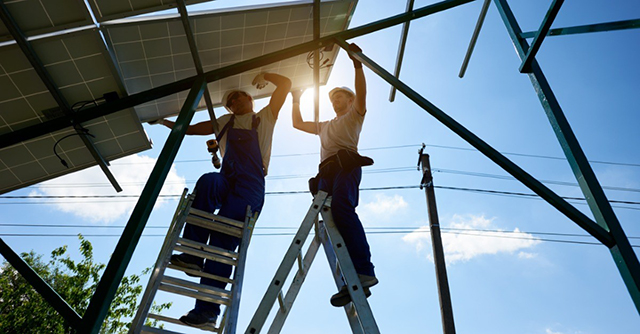
Turkey's power demand has started to normalize with the country’s easing of restrictions to prevent the spread of COVID-19 over the last three months, Alvaro Ortiz, head economist for Big Data at BBVA Research, told Anadolu Agency on Monday.
Demand increased 1% by June 17 compared to the same period last year, Ortiz said.
Turkey took many precautions to fight against the COVID-19 since the first reported case on March 11. From this date onwards, schools, shopping malls, restaurants and cafes closed while a curfew was put in place for weekends while restrictions were placed on the elderly and children going out.
These restrictions had a dramatic impact on the country's power demand with the share of demand decline in April by 16% and May by 17%. But as normalization gradually returned in on June 1 across the country with the lifting of restrictions not only in Turkey but also worldwide, growth figures turned into positive territory.
"The first 17 days of June have been near +1% in year-on-year terms. This is consistent with our Big Data information on both consumer transactions and corporate investment which have already returned to positive nominal growth rates in June after sharp declines in April and May which were around 40% of nominal contractions," Ortiz said.
Volkan Yigit, a partner at APLUS Enerji investment and consultancy company, said decrease in demand had a huge impact on the share of resources used for power generation.
"The share of natural gas in electricity generation fell to historic levels while renewable energy increased its share in the generation mix," he said.
Yigit noted that with the start of normalization in Turkey came a surge in power demand as seen especially in the week between June 15 and 20.
"In this period, the generation from thermal plants including natural gas, imported coal and lignite significantly increased," he said, detailing that the average hourly generation from imported coal rose from 6,500 megawatts to 8,000 megawatts while it hit 5,200 megawatts from 4,300 megawatts in lignite plants.
Yigit also said that the average hourly generation from natural gas plants mounted to 5,300 megawatts from 4,200 megawatts level.
However, Ortiz holds a cautious growth outlook for 2020. "Our forecast for consumption for this year is mildly positive around 0.7% in line with the 2019 growth rate. Consumption has the biggest share in GDP so the evolution of both should be similar."
He added that taking into account the differences between Turkey and the rest of the world, he forecasts that its GDP growth will be near zero, between +2% and -2%.
"We think that Turkey will avoid more negative forecasts of sharp declines around -5% for several reasons," he said. One of these reasons is in Turkey’s growth rate of 4.5% year on year during the first quarter of 2020 compared to most developed economies that posted negative growth rates.
But he warned that despite Turkey’s important buffer for the first quarter, the growth rate would be assessed on an average of the four quarters of the year. Consequently, he said they expect the Turkish economy will post a significant decline due to the COVID-19 in the second quarter, which is forecast to be between -5% and -8% year on year.
"In annualized growth rates, this is consistent with declines of near -30% to -40% which would be a huge hit in the economy. However, it will recover during the third and the fourth quarter given the particular nature of this crisis to compensate for the first half of the year. Thus we expect a near-zero growth this year to recover faster next year," he said warning that COVID-19 remains the main risk, the recovery from which is a delicate balance between health and the economy.
Yigit observed that tourism would be one of the main factors for power demand for the rest of the year but would still not return demand to levels seen in 2019.
"In our main scenario, we expect Turkey's consumption to stand between 296-297 billion kilowatt-hours for 2020. This is around 2% and 2.5% drop compared to the 2019 consumption," he noted.
Burak Kuyan, the head of the Turkish Energy Traders Association (ETD) also agreed that lower electricity demand in April and May would impact trade volumes.
"As of the beginning of June with the normalization process, expectations focused on a rise in demand and this affected the upward trend in trade volumes," he said.
Source: AA

Turkish companies are in talks with Libya's United Nations-backed legitimate government, the Government of National Accord (GNA), to meet the urgent need for electricity in the country, which sees up to 10 hours of power cuts per day. The first steps are expected to be the sending of a powership while strengthening the country’s infrastructure and the plants it has already built.
A Turkish delegation that included Foreign Minister Mevlut Cavusoglu, Treasury and Finance Minister Berat Albayrak, Presidential Spokesperson Ibrahim Kalin and the head of Turkey's National Intelligence Organization (MIT), Hakan Fidan, on Wednesday visited the Libyan capital Tripoli, where they held a series of meetings with the GNA. The power cuts in the country and solutions to meet the rising demand were among the topics discussed during the delegation's meetings. Turkey’s Ministry of Commerce also asked Turkish conglomerate Calik Holding's Calik Enerji, Karadeniz Holding's Karpowership and Aksa Enerji, to submit project proposals regarding Libya's electricity problem.
The urgent need of the country is to solve the power cuts that leave the country without electricity for eight to 10 hours a day. The issue is now set to be solved with a powership to be sent by Turkish conglomerate Karadeniz Holding, which owns the world’s only powership fleet. Aksa Enerji and Calik Enerji will then work both to establish power plants and provide infrastructure and distribution services.
Currently, only 5,000 megawatts (MW) of power can be used in war-torn Libya, which has an installed capacity of 8,000 MW. In addition to the repair of the damaged power plants and efforts to make them operational again, the Libyan Ministry of Electricity plans to add an additional 2,000 MW of power to the existing installed power with the power plants to be built in the coming period.
Zeynep Harezi, energy trade group chairman of Karadeniz Holding, said they are ready to supply electricity to different regions of Libya in 30 to 60 days with the 1,000 MW powership. Harezi, explaining that the powership can supply electricity to the country's network for more than eight hours as a solution to the current power cuts, said that they can send the powership to start producing electricity from this summer, “predicting that it will take longer for Libya to establish land power plants."
Floating power plants, which can meet the energy needs of countries in a short time with turnkey installation, can easily be connected to electricity networks. Karadeniz Holding, which is the owner, operator and builder of the first powership fleet in the world, has 19 floating power plants in 11 different countries, including Indonesia, Lebanon, Mozambique, Ghana, Gambia, Senegal and Cuba. The capacity of the 25 powerships that the company has constructed is 4,100 MW.
Calik Enerji is also in contact with the Libyan Ministry of Electricity. The company, which has commissioned the 550 MW power plant in al-Khums city and handed it over to the Libya administration, plans to commission 1,000 MW of installed power with various projects. The company is negotiating with the Tripoli administration to renew power plants, install new ones and renew transmission lines.
Al-Khums Power Station, which produces 6% of Libya's current installed power, was handed over to the Ministry of Electricity in 2018. Along with Calik Enerji, ENKA, which is among Turkey's largest construction and energy companies, previously built large-scale power plants in Libya that are now in the production stage and waiting to provide much-needed electricity to the region. To date, most of the work at the Ubari gas-fired power plant, built by ENKA, has been completed, and its test connection to the Libyan power grid was completed in October 2017. However, the plant area was evacuated several times in the past few years due to increasing security problems in the region. According to World Bank data, 97% of Libyans had access to electricity in 2002, while this rate declined steadily and fell to 67% in 2018.
Source: Daily Sabah

The International Energy Agency (IEA) on Thursday called for the European Union to accelerate low-carbon building renovations and introduce schemes to encourage consumers to replace inefficient old cars and fridges as part of a post-pandemic “green” recovery.
Setting out its policy recommendations for the EU, the IEA said new policies would help ensure the European Commission’s proposed 750 billion euro recovery fund boosts clean energy and avoids a sustained rebound in emissions after the pandemic.
As the Commission aims to steer the bloc towards becoming climate neutral by 2050, the IEA said energy-saving stimulus investments should be a “prime target”.
Low-carbon building renovations - guided by stricter EU building standards - would help cut bills for Europe’s 513 million energy consumers, while public schemes could encourage consumers to replace old cars and refrigerators with new, efficient ones. The IEA said the virus-induced drop in fuel prices is an opportunity for the EU to phase out fossil fuel subsidies and reform taxes to favour low-carbon energy. Planned changes to EU state aid rules next year should enable public investments in large hydrogen and lithium-ion battery projects.
The Commission has said EU recovery spending must “do no harm” to its aim to cut net greenhouse gas emissions to zero by 2050 - down from more than 4 billion tonnes of CO2 equivalent today.
“Policies will play an essential role in ensuring the effective use of the recovery funds,” IEA executive director Fatih Birol said. With renewable energy investments in Europe expected to fall by a third this year compared with 2019, the IEA said EU research funding and European Investment Bank support must help offset this “historic” drop. Renewables already make up 32% of the EU power mix. But outside the power sector, the IEA said Europe’s energy transitions “have only just begun”, and recommended tougher energy saving requirements for industry - the bloc’s largest energy-consuming sector.
Source: Reuters

COVID-19 disruptions will reduce the annual smart meter shipments in 2020 by 25%, according to a new report issued by ABI Research.
This means year on year revenue will decline by 31% or $3.3 billion to reach $7.39 billion. The smart electric meter sector is expected to record the sharpest contraction with a 30% year on year decrease in annual shipments.
The smart water and gas meter segments will record year on year decreases of 19% and 5%, respectively. Shipments will decline the most in Europe, followed by Asia Pacific and North America. In terms of revenue, the APAC region will be affected the most followed by Europe and North America as revenue shrinks by 34%, 31%, and 30% respectively. Price erosion has also accelerated due to the greater availability of lower-cost smart meters further depressing revenues for original equipment manufacturers.
Adarsh Krishnan, a principal analyst at ABI Research, said: “As energy and water utilities prioritise their business operations, most utilities have temporarily deferred smart meter installations and have re-allocated resources to field service operations to ensure continuity of services to its end customers.
“Meter installation delays have also been driven by service providers and utilities complying with government guidelines on social distancing. That said, utilities that have already initiated smart meter installation programmes are expected to immediately resume those installations as soon as government restrictions are eased.”
However, market revenue is expected to bounce back in 2021 with a 36% YoY growth in annual shipments and revenues exceeding $9.5 billion.
Source: Smart Energy International

A six-seater battery-powered aircraft flew for the first time over the UK on Monday (22 June), becoming Europe’s largest e-plane in the process just as the aviation industry revealed that it wants the EU to invest big in the future of flight innovation.
US startup ZeroAvia’s milestone moment is the latest step in its quest to develop fuel cell technology for commercial aircraft, with the objective of using zero-emission hydrogen to power 200-seater planes for up to 5,500km by 2040.
The firm insists that “fundamental scientific breakthroughs” are actually not needed to achieve its lofty 2040 goal and aims to roll out 20-seater planes within three years. Aircraft with configurations of up to 100 seats could be in service by the end of the decade.
“We all want the aviation industry to come back after the pandemic on a firm footing to be able to move to a net-zero future, with a green recovery,” said ZeroAvia Founder and CEO Val Miftakhov.
“That will not be possible without realistic, commercial options for zero-emission flight, something we will bring to market as early as 2023.”
Monday’s test flight deployed batteries to drive the propeller engine but ZeroAvia says that hydrogen “has a much more promising energy-to-weight ratio, making it viable for commercial operations at a much larger scale and in a shorter time frame.”
Airbus has recently abandoned plans to develop a regional aircraft powered by an electric-hybrid system, due to pressure exerted by the virus outbreak. The aerospace giant could yet resurrect the project after the French government unveiled a €15 billion bailout for the sector, including a fund dedicated to testing low- and zero-emission aircraft.
Source: Euractiv

Governments can align immediate economic stimulus needs with medium to long-term decarbonisation and sustainable development objectives by targeting policy measures and public spending towards the energy transformation, a new report by the International Renewable Energy Agency (IRENA) published today finds.
Post-COVID recovery: An agenda for resilience, development and equality report outlines immediate stimulus action for the next three years (2021-2023) as well as measures for a mid-term 2030 recovery perspective over the next decade. It provides practical insights and recommendations for governments as they drive investment and policy actions for post-COVID-19 economies. The report shows that on an annual basis, scaling-up public and private energy spending to USD 4.5 trillion per year would boost the world economy by an additional 1.3%, creating 19 million additional energy transition-related jobs by 2030. Jobs in renewables alone could triple to 30 million by 2030. Every million dollars (USD) invested in renewables would create three times more jobs than in fossil fuels.
"Renewables have proven to be the most resilient energy sources throughout the current crisis”, said Francesco La Camera, Director-General of IRENA. “This evidence should allow governments to take immediate investment decisions and policy responses to overcome the crisis. With today’s recovery plan for governments, IRENA uses its global mandate on energy transitions to inform decision-making at this critical time, while staying on course toward a fully decarbonised system by 2050.
Doubling annual transition investments to USD 2 trillion over the next three years will provide an effective stimulus and can leverage private sector investments by a factor 3-4. Reforming fossil fuel prices, retiring fossil fuel assets, driving green financing and bailouts, and strategically investing in energy transition must be immediate priorities, IRENA’s report advises.
The annual USD 2 trillion invested would boost GDP by 1% and create additional 5.5 million transition-related jobs in three years. Underpinning labour and industrial policies are required to leverage local capacities and skills and create industries and jobs across the value chain.
Any recovery strategy should include innovative solutions and emerging technologies such as green hydrogen with the potential to eventually deliver a net zero energy system. By investing in their commercialisation, governments and businesses can ensure sustained long-term growth.
Renewable-based power generation would become the backbone of future energy markets, supported by transition-related industries like battery storage. But renewable heating and cooling must also be scaled up along with energy efficiency. Renewable-based transport scan expand with incentives for electric vehicles (EVs) and continued infrastructure investment (including smart grids and EV charging stations), as well as emerging fuel solutions.
"Now is the time to invest in a better future”, said La Camera. “Government policies and investment choices can create the necessary momentum to enact systemic change and deliver the energy transformation away from fossil fuels. Driving a structural shift towards cleaner energy systems and more resilient economies and societies is more urgent than ever. Most of all, this is a global agenda, and we must leave no one behind."
Source: IRENA
Global Economic Prospects
COVID-19 has triggered the deepest global recession in decades. While the ultimate outcome is still uncertain, the pandemic will result in contractions across the vast majority of emerging market and developing economies. It will also do lasting damage to labor productivity and potential output. The immediate policy priorities are to alleviate the human costs and attenuate the near-term economic losses. Once the crisis abates, it will be necessary to reaffirm a credible commitment to sustainable policies and undertake the reforms necessary to buttress long-term prospects. Global coordination and cooperation will be critical.
Please click here to read the full report.

